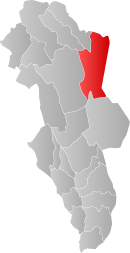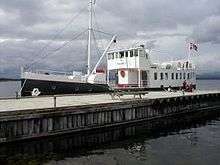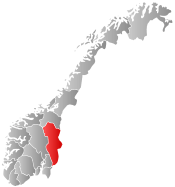Engerdal
| Engerdal kommune | |||
|---|---|---|---|
| Municipality | |||
| |||
 Engerdal within Hedmark | |||
| Coordinates: 61°53′N 12°2′E / 61.883°N 12.033°ECoordinates: 61°53′N 12°2′E / 61.883°N 12.033°E | |||
| Country | Norway | ||
| County | Hedmark | ||
| District | Østerdalen | ||
| Administrative centre | Engerdal | ||
| Government | |||
| • Mayor (2007) | Reidar Åsgård (Ap) | ||
| Area | |||
| • Total | 2,197 km2 (848 sq mi) | ||
| • Land | 1,916 km2 (740 sq mi) | ||
| Area rank | 24 in Norway | ||
| Population (2004) | |||
| • Total | 1,503 | ||
| • Rank | 368 in Norway | ||
| • Density | 1/km2 (3/sq mi) | ||
| • Change (10 years) | -17.1 % | ||
| Demonym(s) | Engerdøl[1] | ||
| Time zone | CET (UTC+1) | ||
| • Summer (DST) | CEST (UTC+2) | ||
| ISO 3166 code | NO-0434 | ||
| Official language form | Bokmål | ||
| Website |
www | ||
|
| |||
Engerdal is a municipality in Hedmark county, Norway. It is part of the traditional region of Østerdalen. The administrative centre of the municipality is the village of Engerdal. The new municipality of Engerdal was created on 1 January 1911 from parts of the municipalities of Tolga, Trysil, Ytre Rendal, and Øvre Rendal.
General information
Name
The first element is the river name Engera and the last element is dal, the word for "valley" or "dale". The river name is derived from the name of the lake Engeren, and this is probably derived from the Old Norse word ongr which means "narrow".
Coat-of-arms
The coat-of-arms is from modern times. They were granted on 8 February 1991. The arms show two pieces of a horse harness (the hames) in gold on a green background. The two objects symbolize the ties between horse and man and at the same time the connection between work and recreation.[2]
Geography
The municipality is located in the northeast part of Hedmark county. It is bordered by Sweden to the north and east, the municipality of Trysil to the south, Rendalen to the west, and Os and Tolga to the northwest.
The greater part of Lake Femunden and roughly half of the Femundsmarka National Park also lie within the boundaries of the municipality.
National parks
Engerdal consists of two national parks. Femundsmarka National Park was founded in 1971 and is situated in the north-east of the municipal. The area is popular for its many lakes and attracts a lot of sport - fishers every year. The same lakes are also perfect for padling the canoe. Due to its large continuously, untouced and protected area, the national park is one of Southern-Scandinavia largest and the area has become a base for many rare animal species.
The second national park, Gutulia National Park is much smaller, but has a more vigorous complex of trees and bogs. It was founded in 1968 and the many large, but old pines dominates the area.
Economy
The most important industries in the municipality are agriculture and travel and tourism. The area of agricultural activity constitute 13,000 acres, which includes about 60 operating units. Due to a harsh climate the agricultural activity is mainly based around production of domestic animals, such as sheep and milk production. Another important activity is forestry. The total area of forestry make up 1,000,636 acres, where 517,680 of this is in fact productive land. 40 percentage of the forest consists of spruce and 60 of pine The main owner of the land is the Norwegian state, while the rest is divided between private land owners and some belongs to the municipality; Engerdal kommuneskoger (KF).
Tourism
Due to growth in building secondary residences in the municipality, recreation and leisure activities has become important for those visiting Engerdal and this have had a positive effect on the municipality's travel and tourism industry. Tourists visiting Engerdal will experience a great wilderness with outdoor activities and adventures. Today, a great complex of attractions, activities and museums will reflect the municipals long history and many of them have become important businesses for economic growth, also keeping the cultural heritage intact.
Museums
Blokkodden Villmarksmuseum is an outdoor museum situated along highway 26 in Drevsjø. Its aim is to document the historical exploitation of the wilderness and natural resources in the municipal. You will experience the cultural heritage dated all the way back from the 1700th century and you will get an impression of how people lived and worked here in the past.
Engerdal is the only municipality in Hedmark county with a full-time working Sami community, and it marks the current southernmost border of the traditional Sami region, Sápmi, within Norway. The museum, therefore, exhibit artifacts and buildings from this culture.
The museum is open everyday from 1 July to 12 August. Guided tours are available and people can participate in special local arrangements, such as learning about "Falkefangst". About 300–400 years ago, this was a way of hunting Falcons in the mountains.
Attractions
In 1886 the steamship company Fæmund was established and they invested in a wooden steamship, which today holds the same name: M/S Femund II. From then and still going today, the steamship cargos important goods for the locals and has become an important transportation for tourists wanting to visit the national parks along the lake.

People
See also
References
- ↑ "Navn på steder og personer: Innbyggjarnamn" (in Norwegian). Språkrådet. Retrieved 2015-12-01.
- ↑ Norske Kommunevåpen (1990). "Nye kommunevåbener i Norden". Retrieved 2008-12-21.
External links
 Media related to Engerdal at Wikimedia Commons
Media related to Engerdal at Wikimedia Commons The dictionary definition of Engerdal at Wiktionary
The dictionary definition of Engerdal at Wiktionary- Municipal fact sheet from Statistics Norway
- Information about Femundsmarka National Park
- Information about Femundsmarka National Park (Norwegian)
- The municipality's official home page


